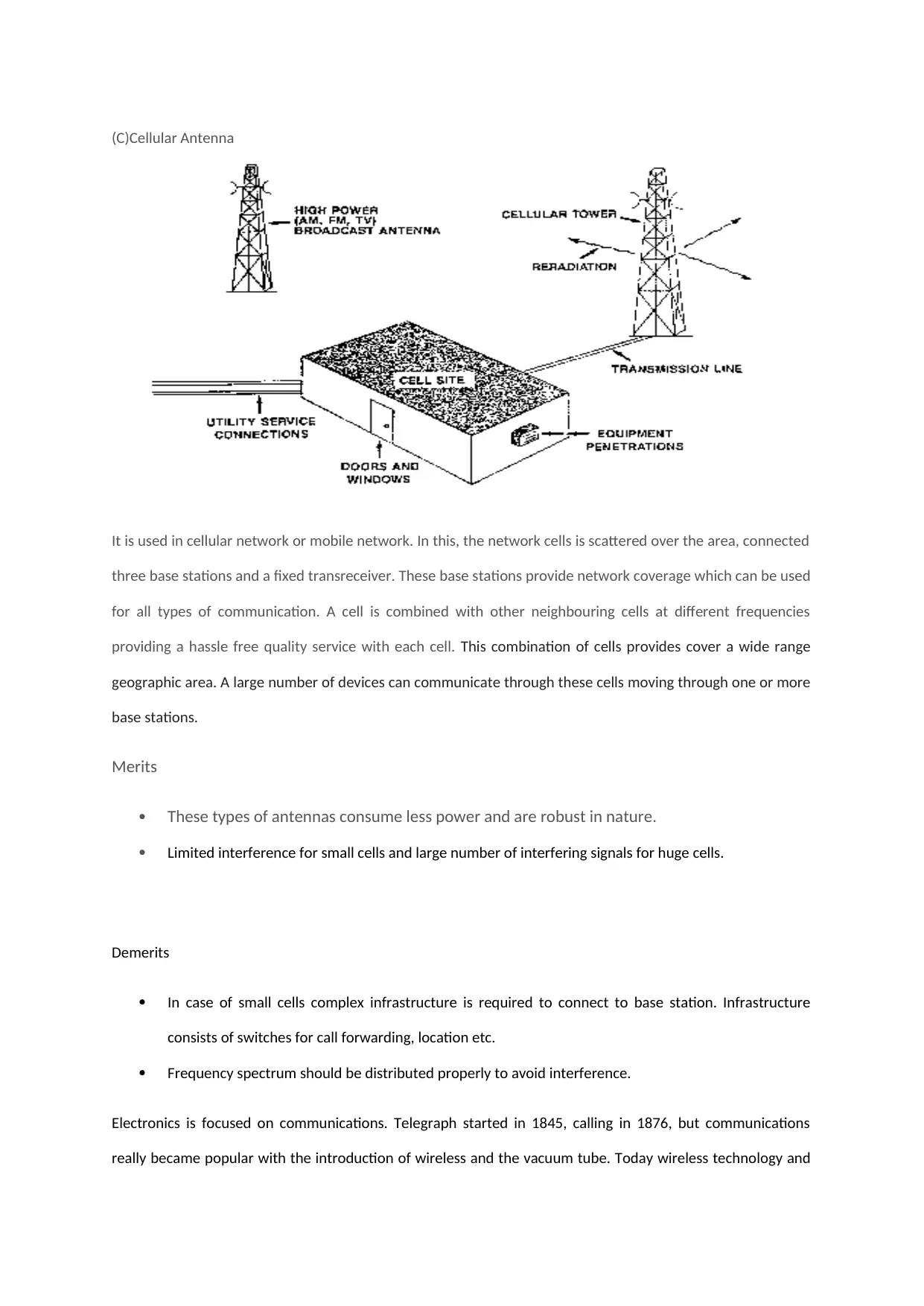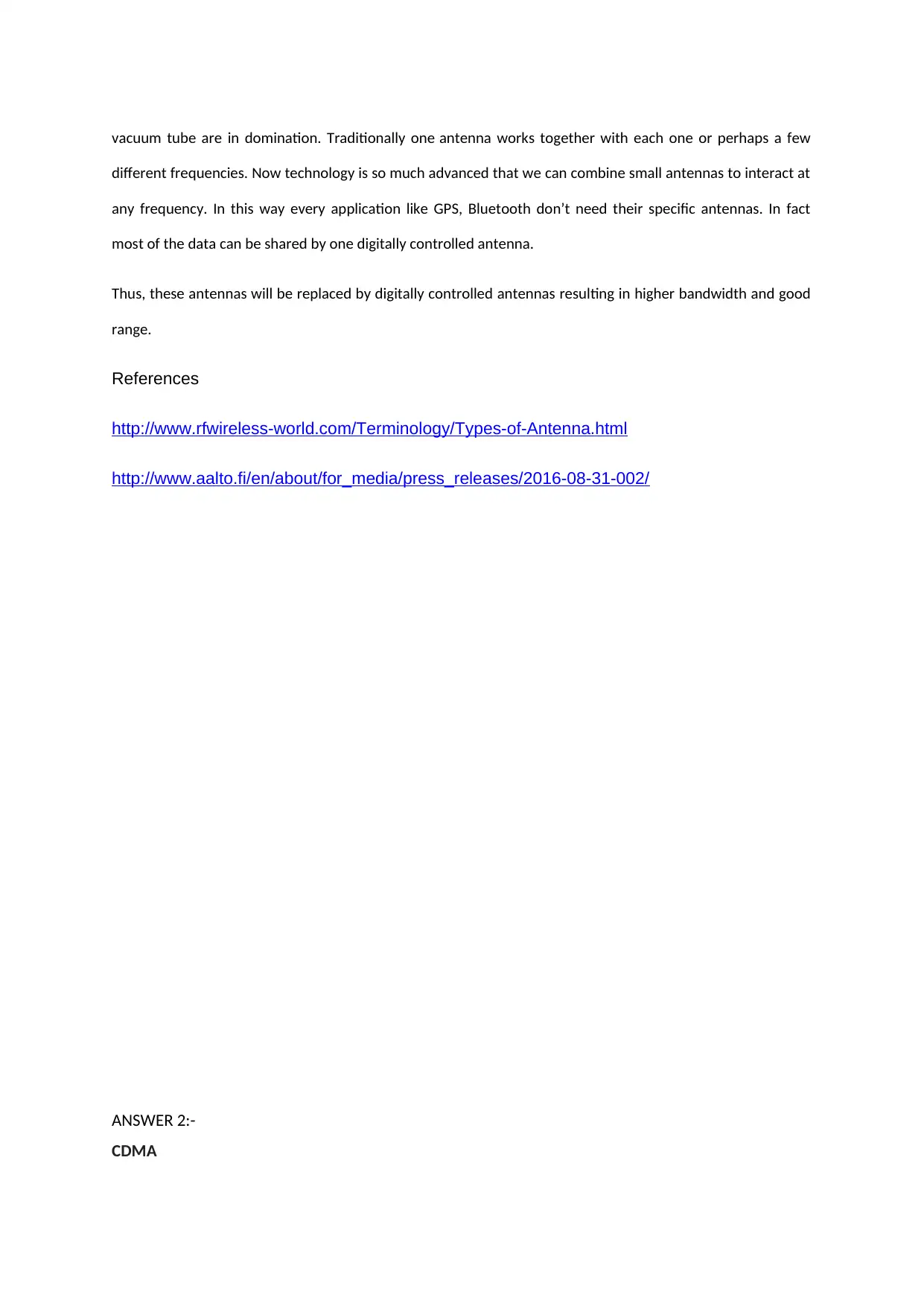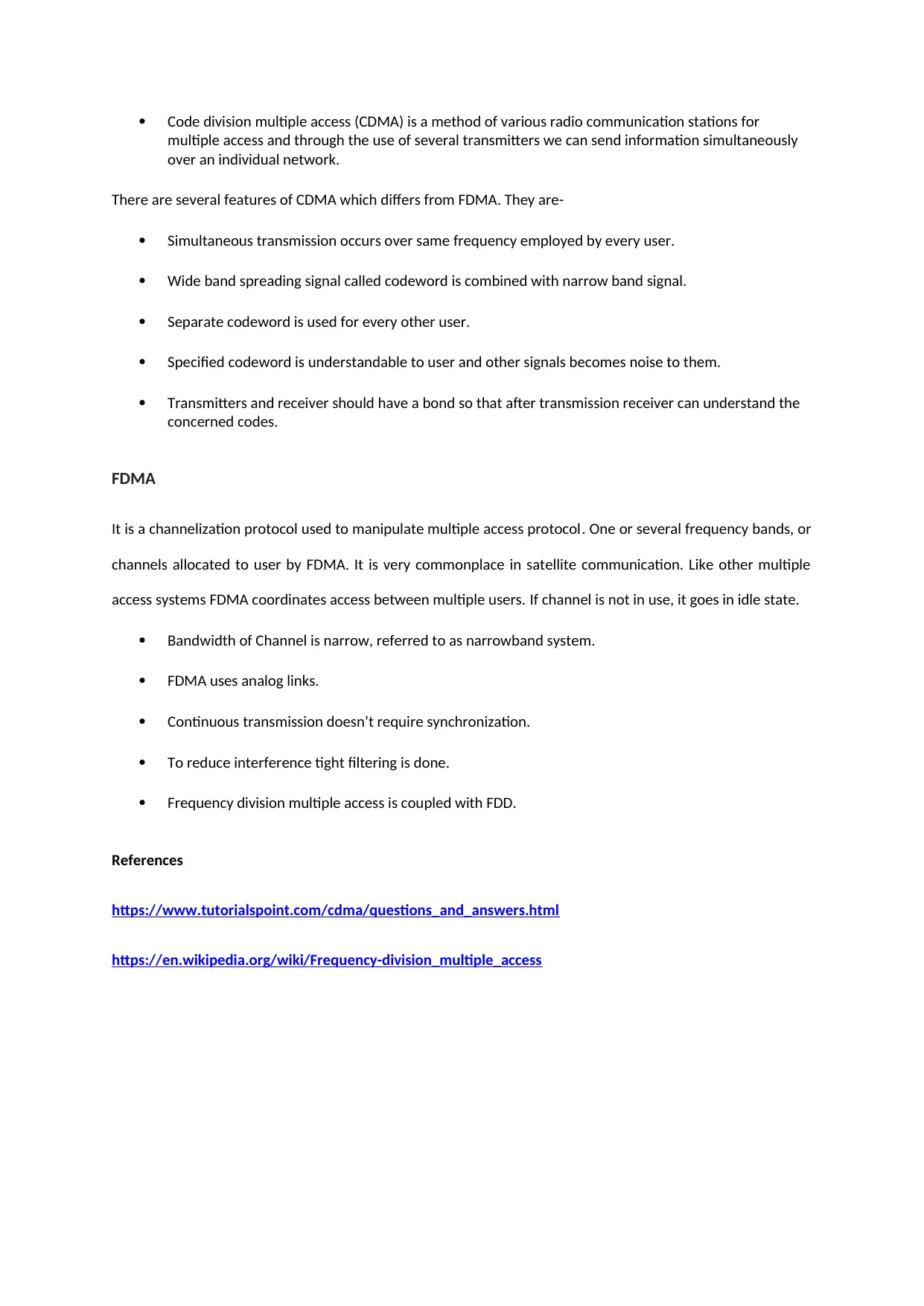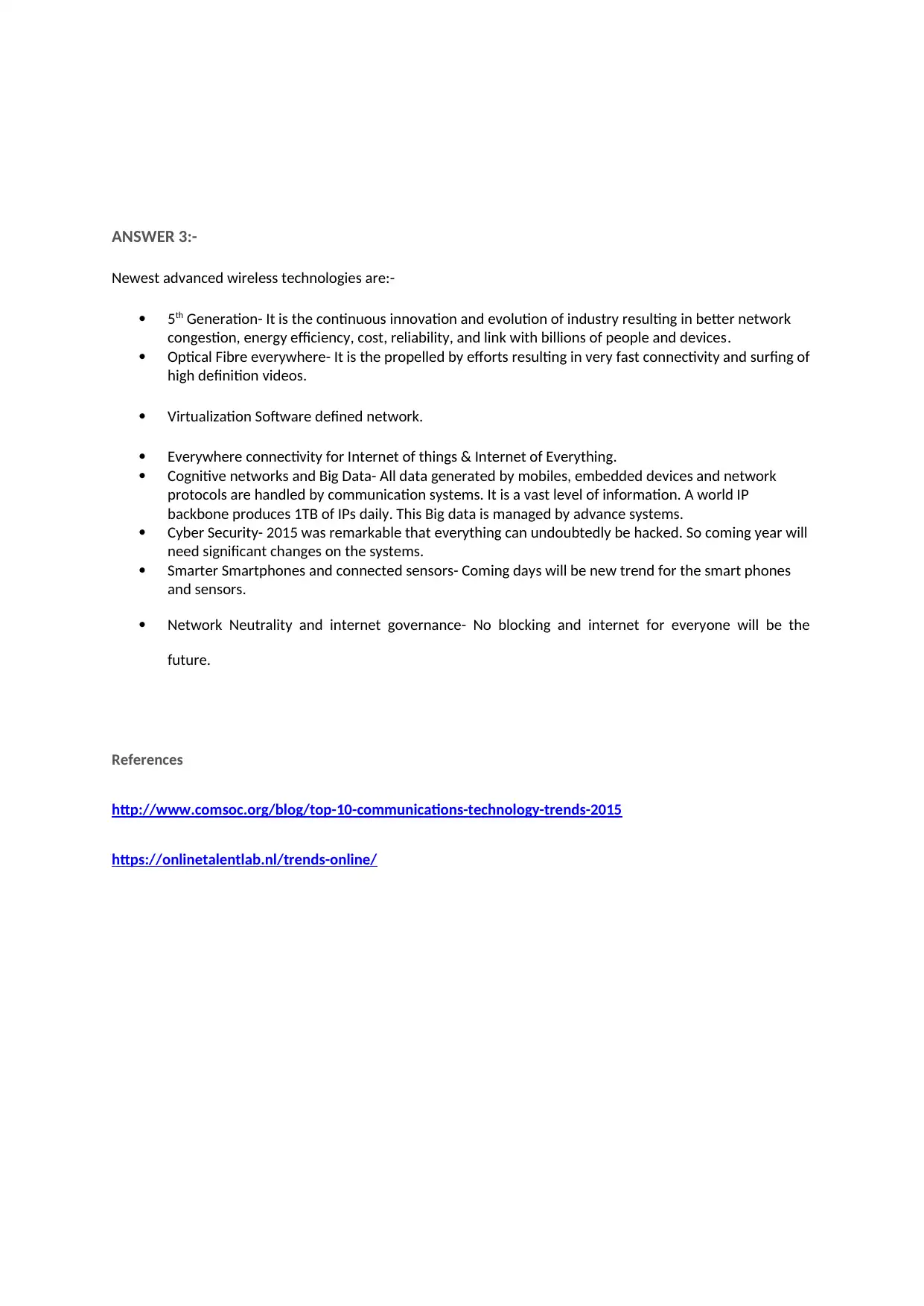Comprehensive Study on Antennas, CDMA, and Wireless Technologies
VerifiedAdded on 2020/03/02
|6
|1130
|37
Homework Assignment
AI Summary
This homework assignment provides a comprehensive overview of antennas and wireless technologies. It begins by detailing the properties of antennas, including orifice, directivity, and bandwidth, and then explores different antenna types such as horn antennas, Yagi antennas, and cellular antennas, outlining their functionalities, advantages, and disadvantages. The assignment then delves into CDMA (Code Division Multiple Access) and FDMA (Frequency Division Multiple Access) methods, comparing their features and applications in radio communication. Finally, the document addresses the newest advanced wireless technologies, including 5G, optical fiber, virtualization, cognitive networks, cybersecurity, and the future of smartphones and network neutrality, providing insights into current trends and future developments in the field. The assignment is supported by several references to provide additional information.

Answer 1:-
A device called an antenna which resides in an electrical circuit has the capability of converting electric power
to standing radio waves which can be received by transreceivers. Interlinking of transmitter and receiver is
done by antennas. Antennas hold different types of properties.
Properties of Antennas:
Antenna expand
Orifice
Directivity and bandwidth
Divergence
Effective length
Polar diagram.
Different types of antennas are needed to perform different wireless communication. Some of them are-
(A) Horn Antenna
This type of antenna works alongside reflector as a bowl antenna powerfully as a
waveguide.
Mainly microwave and satellite are embedded with horn antenna. If Normal waveguide are used for
transmission then it results in standing waves. Horn antenna prevents the odd things. The more slow but sure
the blaze, better could be the similarality and lesser the losses. This results in greater growth of signal.
Depending upon the blazing there are different types of horn antennas viz. pyramidal, sectoral and
Conical horn. These antennas has several merits and demerits-
Moderate directivity (Ease), broad bandwidth and ease of manufacturing.
Horn antenna operates over a good range of frequencies covering a wide area and has wide
bandwidth.
A device called an antenna which resides in an electrical circuit has the capability of converting electric power
to standing radio waves which can be received by transreceivers. Interlinking of transmitter and receiver is
done by antennas. Antennas hold different types of properties.
Properties of Antennas:
Antenna expand
Orifice
Directivity and bandwidth
Divergence
Effective length
Polar diagram.
Different types of antennas are needed to perform different wireless communication. Some of them are-
(A) Horn Antenna
This type of antenna works alongside reflector as a bowl antenna powerfully as a
waveguide.
Mainly microwave and satellite are embedded with horn antenna. If Normal waveguide are used for
transmission then it results in standing waves. Horn antenna prevents the odd things. The more slow but sure
the blaze, better could be the similarality and lesser the losses. This results in greater growth of signal.
Depending upon the blazing there are different types of horn antennas viz. pyramidal, sectoral and
Conical horn. These antennas has several merits and demerits-
Moderate directivity (Ease), broad bandwidth and ease of manufacturing.
Horn antenna operates over a good range of frequencies covering a wide area and has wide
bandwidth.
Paraphrase This Document
Need a fresh take? Get an instant paraphrase of this document with our AI Paraphraser

(B)Yagi Antenna
A yagi (device that receives TV and radio signals), also known as Yagi Uda organized row is an antenna that
receives signal from one direction. This type of device is popular among radio stations and band radio
operators. It operates over a range greater than 10megahertz.
Yagi Uda antenna uses passive elements. It can be constructed using one or more parabolic reflector elements
and one or more director elements as this antenna is of low cost and greater in efficiency. This type of
antennas can be made by using an antenna with one reflector, a driven folded-dipole, and directors, mounted
for horizontal schism in the presumptuous direction.
Pros of yagi antenna
Yagis have more gain than similarly sized log periodic antennas which gives them a good range.
They are easily mountable at low cost.
Cons of yagi antenna
These antennas have limited bandwidth or frequency.
As you move away from the limited frequency range, the graph shows degradation in gain and
impedance. This is because yagis are based on echoing elements.
A yagi (device that receives TV and radio signals), also known as Yagi Uda organized row is an antenna that
receives signal from one direction. This type of device is popular among radio stations and band radio
operators. It operates over a range greater than 10megahertz.
Yagi Uda antenna uses passive elements. It can be constructed using one or more parabolic reflector elements
and one or more director elements as this antenna is of low cost and greater in efficiency. This type of
antennas can be made by using an antenna with one reflector, a driven folded-dipole, and directors, mounted
for horizontal schism in the presumptuous direction.
Pros of yagi antenna
Yagis have more gain than similarly sized log periodic antennas which gives them a good range.
They are easily mountable at low cost.
Cons of yagi antenna
These antennas have limited bandwidth or frequency.
As you move away from the limited frequency range, the graph shows degradation in gain and
impedance. This is because yagis are based on echoing elements.

(C)Cellular Antenna
It is used in cellular network or mobile network. In this, the network cells is scattered over the area, connected
three base stations and a fixed transreceiver. These base stations provide network coverage which can be used
for all types of communication. A cell is combined with other neighbouring cells at different frequencies
providing a hassle free quality service with each cell. This combination of cells provides cover a wide range
geographic area. A large number of devices can communicate through these cells moving through one or more
base stations.
Merits
These types of antennas consume less power and are robust in nature.
Limited interference for small cells and large number of interfering signals for huge cells.
Demerits
In case of small cells complex infrastructure is required to connect to base station. Infrastructure
consists of switches for call forwarding, location etc.
Frequency spectrum should be distributed properly to avoid interference.
Electronics is focused on communications. Telegraph started in 1845, calling in 1876, but communications
really became popular with the introduction of wireless and the vacuum tube. Today wireless technology and
It is used in cellular network or mobile network. In this, the network cells is scattered over the area, connected
three base stations and a fixed transreceiver. These base stations provide network coverage which can be used
for all types of communication. A cell is combined with other neighbouring cells at different frequencies
providing a hassle free quality service with each cell. This combination of cells provides cover a wide range
geographic area. A large number of devices can communicate through these cells moving through one or more
base stations.
Merits
These types of antennas consume less power and are robust in nature.
Limited interference for small cells and large number of interfering signals for huge cells.
Demerits
In case of small cells complex infrastructure is required to connect to base station. Infrastructure
consists of switches for call forwarding, location etc.
Frequency spectrum should be distributed properly to avoid interference.
Electronics is focused on communications. Telegraph started in 1845, calling in 1876, but communications
really became popular with the introduction of wireless and the vacuum tube. Today wireless technology and
⊘ This is a preview!⊘
Do you want full access?
Subscribe today to unlock all pages.

Trusted by 1+ million students worldwide

vacuum tube are in domination. Traditionally one antenna works together with each one or perhaps a few
different frequencies. Now technology is so much advanced that we can combine small antennas to interact at
any frequency. In this way every application like GPS, Bluetooth don’t need their specific antennas. In fact
most of the data can be shared by one digitally controlled antenna.
Thus, these antennas will be replaced by digitally controlled antennas resulting in higher bandwidth and good
range.
References
http://www.rfwireless-world.com/Terminology/Types-of-Antenna.html
http://www.aalto.fi/en/about/for_media/press_releases/2016-08-31-002/
ANSWER 2:-
CDMA
different frequencies. Now technology is so much advanced that we can combine small antennas to interact at
any frequency. In this way every application like GPS, Bluetooth don’t need their specific antennas. In fact
most of the data can be shared by one digitally controlled antenna.
Thus, these antennas will be replaced by digitally controlled antennas resulting in higher bandwidth and good
range.
References
http://www.rfwireless-world.com/Terminology/Types-of-Antenna.html
http://www.aalto.fi/en/about/for_media/press_releases/2016-08-31-002/
ANSWER 2:-
CDMA
Paraphrase This Document
Need a fresh take? Get an instant paraphrase of this document with our AI Paraphraser

Code division multiple access (CDMA) is a method of various radio communication stations for
multiple access and through the use of several transmitters we can send information simultaneously
over an individual network.
There are several features of CDMA which differs from FDMA. They are-
Simultaneous transmission occurs over same frequency employed by every user.
Wide band spreading signal called codeword is combined with narrow band signal.
Separate codeword is used for every other user.
Specified codeword is understandable to user and other signals becomes noise to them.
Transmitters and receiver should have a bond so that after transmission receiver can understand the
concerned codes.
FDMA
It is a channelization protocol used to manipulate multiple access protocol. One or several frequency bands, or
channels allocated to user by FDMA. It is very commonplace in satellite communication. Like other multiple
access systems FDMA coordinates access between multiple users. If channel is not in use, it goes in idle state.
Bandwidth of Channel is narrow, referred to as narrowband system.
FDMA uses analog links.
Continuous transmission doesn’t require synchronization.
To reduce interference tight filtering is done.
Frequency division multiple access is coupled with FDD.
References
https://www.tutorialspoint.com/cdma/questions_and_answers.html
https://en.wikipedia.org/wiki/Frequency-division_multiple_access
multiple access and through the use of several transmitters we can send information simultaneously
over an individual network.
There are several features of CDMA which differs from FDMA. They are-
Simultaneous transmission occurs over same frequency employed by every user.
Wide band spreading signal called codeword is combined with narrow band signal.
Separate codeword is used for every other user.
Specified codeword is understandable to user and other signals becomes noise to them.
Transmitters and receiver should have a bond so that after transmission receiver can understand the
concerned codes.
FDMA
It is a channelization protocol used to manipulate multiple access protocol. One or several frequency bands, or
channels allocated to user by FDMA. It is very commonplace in satellite communication. Like other multiple
access systems FDMA coordinates access between multiple users. If channel is not in use, it goes in idle state.
Bandwidth of Channel is narrow, referred to as narrowband system.
FDMA uses analog links.
Continuous transmission doesn’t require synchronization.
To reduce interference tight filtering is done.
Frequency division multiple access is coupled with FDD.
References
https://www.tutorialspoint.com/cdma/questions_and_answers.html
https://en.wikipedia.org/wiki/Frequency-division_multiple_access

ANSWER 3:-
Newest advanced wireless technologies are:-
5th Generation- It is the continuous innovation and evolution of industry resulting in better network
congestion, energy efficiency, cost, reliability, and link with billions of people and devices.
Optical Fibre everywhere- It is the propelled by efforts resulting in very fast connectivity and surfing of
high definition videos.
Virtualization Software defined network.
Everywhere connectivity for Internet of things & Internet of Everything.
Cognitive networks and Big Data- All data generated by mobiles, embedded devices and network
protocols are handled by communication systems. It is a vast level of information. A world IP
backbone produces 1TB of IPs daily. This Big data is managed by advance systems.
Cyber Security- 2015 was remarkable that everything can undoubtedly be hacked. So coming year will
need significant changes on the systems.
Smarter Smartphones and connected sensors- Coming days will be new trend for the smart phones
and sensors.
Network Neutrality and internet governance- No blocking and internet for everyone will be the
future.
References
http://www.comsoc.org/blog/top-10-communications-technology-trends-2015
https://onlinetalentlab.nl/trends-online/
Newest advanced wireless technologies are:-
5th Generation- It is the continuous innovation and evolution of industry resulting in better network
congestion, energy efficiency, cost, reliability, and link with billions of people and devices.
Optical Fibre everywhere- It is the propelled by efforts resulting in very fast connectivity and surfing of
high definition videos.
Virtualization Software defined network.
Everywhere connectivity for Internet of things & Internet of Everything.
Cognitive networks and Big Data- All data generated by mobiles, embedded devices and network
protocols are handled by communication systems. It is a vast level of information. A world IP
backbone produces 1TB of IPs daily. This Big data is managed by advance systems.
Cyber Security- 2015 was remarkable that everything can undoubtedly be hacked. So coming year will
need significant changes on the systems.
Smarter Smartphones and connected sensors- Coming days will be new trend for the smart phones
and sensors.
Network Neutrality and internet governance- No blocking and internet for everyone will be the
future.
References
http://www.comsoc.org/blog/top-10-communications-technology-trends-2015
https://onlinetalentlab.nl/trends-online/
⊘ This is a preview!⊘
Do you want full access?
Subscribe today to unlock all pages.

Trusted by 1+ million students worldwide
1 out of 6
Related Documents
Your All-in-One AI-Powered Toolkit for Academic Success.
+13062052269
info@desklib.com
Available 24*7 on WhatsApp / Email
![[object Object]](/_next/static/media/star-bottom.7253800d.svg)
Unlock your academic potential
Copyright © 2020–2025 A2Z Services. All Rights Reserved. Developed and managed by ZUCOL.




